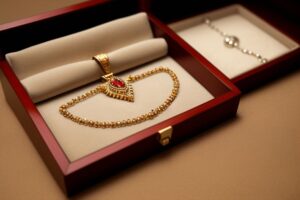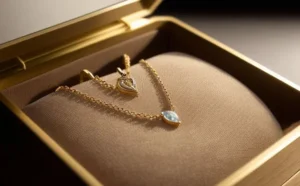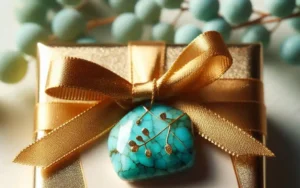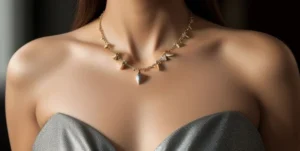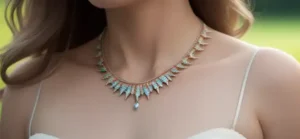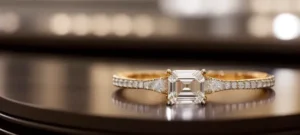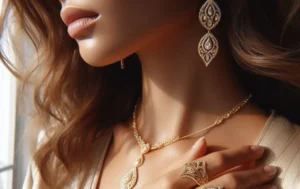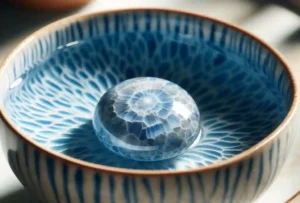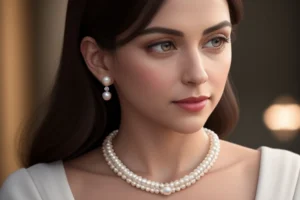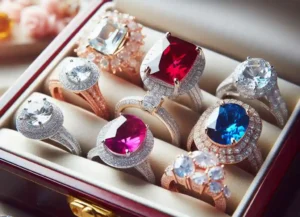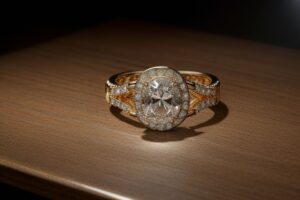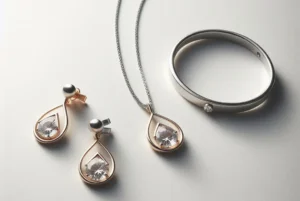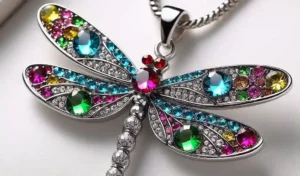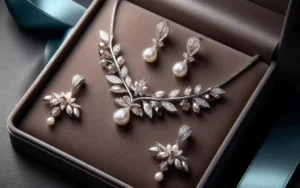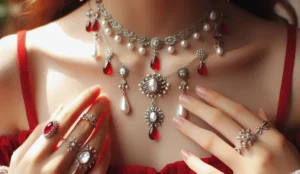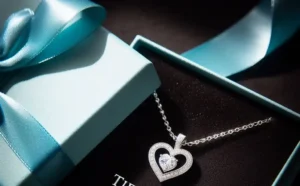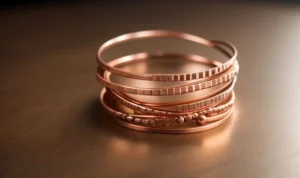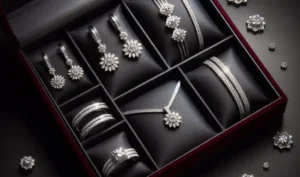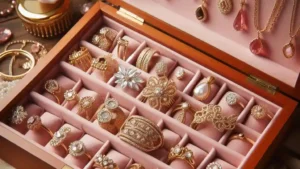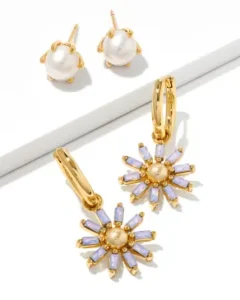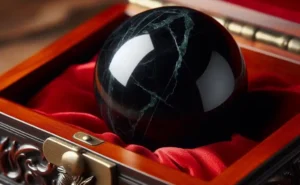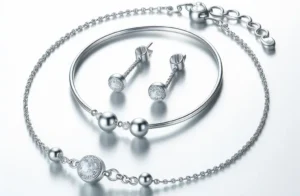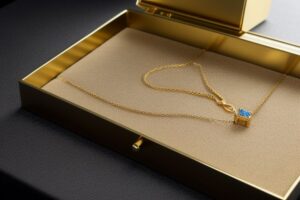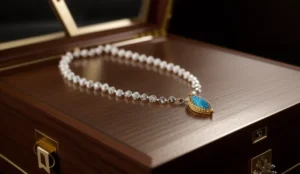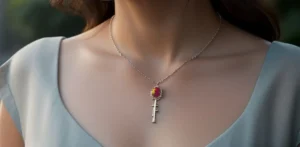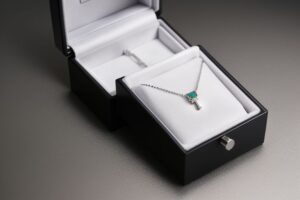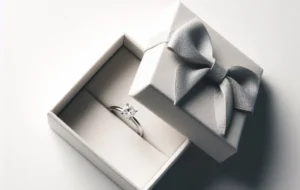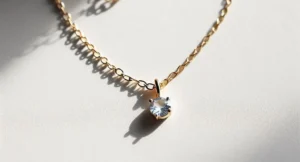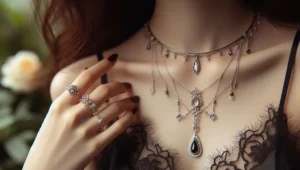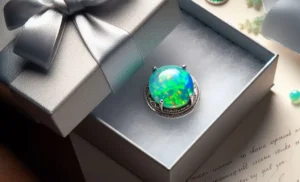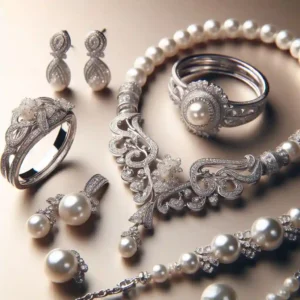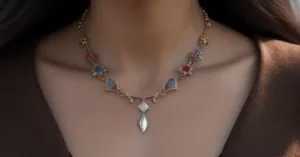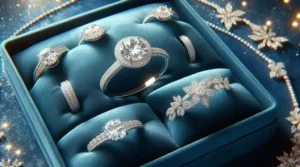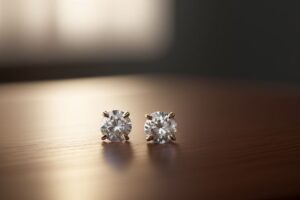Why Do People Wear Chokers? Chokers have been captivating fashion enthusiasts for centuries, wrapping around the necks of people across different cultures and eras.
But what is it about these tight-fitting necklaces that continue to fascinate and adorn wearers even today?
This blog post delves into the various facets of chokers, exploring why they continue to be an enduring element of style and personal expression.
Why Do People Wear Chokers?

– Fashion Statement: Chokers stand out as a bold accessory that can transform any outfit, elevating one’s style quotient instantly. They serve as a focal point, drawing attention towards the face and neck area.
– Versatility: Their wide range of designs, from minimalistic bands to intricate lace or jewel-encrusted pieces, allows chokers to be paired with various attire, suiting different occasions and personal styles.
– Expression of Identity: Chokers offer a unique way for individuals to express facets of their personality, mood, or affiliations. The choice of a choker can signify everything from a rebellious spirit to an affinity for elegance.
– Cultural Connection: Some wear chokers as a nod to cultural heritage or to connect with historical fashion trends, appreciating the accessory’s rich background and evolution through time.
– Symbolic Meanings: For many, chokers carry deeper symbolic value, representing aspects like protection, empowerment, or belonging to a particular community or ideology.
– Trend Influence: Influenced by celebrity fashion and popular media, chokers have become a trendy accessory. People often adopt them as part of their wardrobe to align with current fashion trends or emulate admired personalities.
– Personal Comfort and Preference: Beyond external influences, many choose chokers simply because they like how they look and feel when wearing them, finding comfort in the accessory’s snug fit and aesthetic appeal.
A Brief History of Chokers: From Ancient Times to Modern Day
Tracing the lineage of chokers reveals a journey that spans millennia, beginning in the ancient civilizations that first inhabited the earth. These early adornments, crafted from natural materials such as vines, bones, and shells, were not merely decorative but often imbued with protective qualities and spiritual significance.
As civilizations evolved, so did the materials and meanings attached to these neckpieces. The Egyptians, for instance, believed chokers possessed magical properties, using them to protect their royalty in the afterlife.
By the time of the Middle Ages, chokers had found their way into European fashion, albeit with a more sinister undertone, being associated with prostitution.
However, this perception shifted dramatically by the Renaissance, when they were seen as a symbol of luxury, worn by the elite to display their wealth and status through elaborate designs featuring pearls and precious stones.
The 19th century marked another pivotal era for chokers, with the Victorian elite embracing them as a staple of high fashion. This period introduced the ‘dog collar’ style, heavily adorned with diamonds and lace, signifying the peak of luxury and refinement.
The 20th century witnessed the democratization of chokers, as they oscillated between periods of high fashion and subcultural rebellion. The punk and grunge movements of the late 20th century repurposed the choker as a symbol of anti-establishment sentiments, a stark contrast to its aristocratic origins.
This rich tapestry of historical context sets the stage for the choker’s modern resurgence, reflecting its adaptability and enduring appeal across different eras and social strata.
The Aesthetic Appeal of Chokers: Enhancing Personal Style
Chokers possess the distinctive ability to accentuate the neck, create a visual focus near the face, and elevate one’s physical attributes with an air of uniqueness. Their transformative power is evident, as they can turn a casual outfit into a statement ensemble with just the addition of this single accessory.
What sets chokers apart is their remarkable versatility, catering to an array of fashion sensibilities. Whether one gravitates towards the dark allure of gothic fashion or prefers the understated elegance of minimalism, there’s a choker design that perfectly aligns with their aesthetic.
This adaptability extends to various occasions too, from formal events where a pearl-embellished choker can add a touch of grace, to everyday wear where a leather band reflects a more laid-back, edgy vibe. The choice of a choker can also subtly communicate one’s mood or personality for the day—be it playful, mysterious, or bold.
Additionally, the inclusion of different materials and embellishments allows individuals to further customize their look, making every choker a unique addition to their personal style narrative.
Through these nuances, chokers serve not just as accessories, but as vital components of self-expression, enabling wearers to project their inner self in a visually compelling way.
Symbolism and Cultural Significance: Beyond Just Fashion
Chokers hold layers of symbolism and cultural import that stretch far beyond their role as mere fashion accessories. They can serve as a powerful medium for conveying a myriad of messages, from strength and protection to rebellion and freedom.
Historically, chokers have been worn as amulets, believed to safeguard the wearer against harm and to endow them with strength. This protective symbolism is seen in many cultures around the world, where chokers are imbued with spiritual or magical significance.
In addition to their protective qualities, chokers have also been symbols of high social status and power. The intricate and luxurious chokers of the Renaissance and Victorian eras, heavily adorned with jewels and precious metals, are prime examples of how these accessories were once exclusive markers of wealth and aristocracy.
Conversely, their adoption by subcultural movements in more recent times reflects a starkly different symbolism—one of dissent, nonconformity, and a challenge to traditional societal norms.
Chokers also hold significant gendered and feminist symbolism. In various historical and modern contexts, they have been embraced as symbols of women’s empowerment and autonomy, challenging traditional notions of femininity and decorum. For some, wearing a choker is a bold assertion of self-ownership and a rejection of constraining stereotypes.
This rich tapestry of meanings underscores the choker’s enduring significance. Far from being simply decorative, chokers embody a complex interplay of personal and collective identities, beliefs, and values, making them a uniquely potent form of cultural expression.
Chokers as a Form of Self-Expression and Identity
In the tapestry of personal adornment, chokers stand out as a bold canvas for self-expression and the exploration of identity. This unique accessory provides an avenue for individuals to convey aspects of their personality without uttering a single word.
For some, a choker is a symbol of rebellion, a deliberate choice that distances them from mainstream norms and expectations. For others, it’s a badge of belonging, a way to visually connect with a specific community or ideology.
The beauty of chokers lies in their versatility; they can be both a statement of defiance and a declaration of allegiance.
Delving deeper, the choice of choker often reflects the wearer’s journey, interests, or even their stance on issues. A leather band might echo a person’s edgy and daring side, while a delicate lace piece whispers of elegance and subtlety.
In the same vein, the colors, materials, and designs chosen can hint at deeper layers of one’s story or emotional state, offering glimpses into the wearer’s soul.
Moreover, the act of choosing and wearing a choker can be a form of personal empowerment. By selecting how to adorn one’s neck—a visually prominent and sometimes vulnerable part of the body—individuals reclaim agency over their appearance and, by extension, their identity.
In this light, chokers transcend their role as mere accessories; they become integral components of the wearer’s self-presentation and identity exploration.
The Role of Chokers in Popular Culture and Media
Chokers have consistently been in the limelight, propelled by their frequent sightings on the necks of celebrities, influencers, and style icons who grace the pages of magazines and the screens of various digital platforms.
These prominent figures often leverage chokers as a tool for accentuating their fashion choices, igniting trends that ripple through the masses.
The impact of pop culture is undeniable as it shapes perceptions and dictates fashion norms, making chokers a go-to accessory for those looking to mirror the glamor and edginess seen in their favorite personalities.
On screen, chokers have adorned characters across a spectrum of genres, from period dramas where they add a touch of historical authenticity, to modern narratives where they symbolize a character’s personality or status.
These appearances not only highlight the accessory’s versatility but also contribute to its narrative value, adding layers to character development and plot dynamics. Music videos, too, have played a significant role in popularizing chokers, with artists often using them as part of their on-stage persona or as symbols intertwined with the themes of their music.
The interplay between chokers, popular culture, and media has thus been a dance of mutual influence. As chokers evolve in design and significance, their portrayal in media continues to reflect and shape societal trends, ensuring their place in the spotlight remains undisputed.
Psychological and Social Influences: Why We Follow Trends
The allure of chokers, and indeed many fashion trends, can be traced back to our deep-rooted psychological need for social acceptance and identity formation.
This desire compels us to mirror the styles and behaviors seen within our preferred social circles or admired figures, making fashion choices like chokers symbols of our allegiance to these groups. Fashion serves not only as a means of individual expression but also as a way to communicate our belonging to or aspiration towards certain communities.
The role of social media and celebrity influence cannot be understated in this context; the visibility of chokers on influential personalities amplifies their desirability, encouraging us to adopt this trend as part of our own identity and wardrobe.
Moreover, the choker’s recurring popularity highlights the social phenomenon of trend cycles, where past styles resurface, reinterpreted to fit contemporary tastes and values. This cyclical nature speaks to our collective nostalgia and the comfort found in the familiar, while also offering a canvas for innovation and personal reinterpretation.
As we navigate these social and psychological landscapes, our fashion choices, including the embracing of chokers, become intertwined with our quest for individuality and belonging within the broader tapestry of society.
Chokers Today: A Diverse and Inclusive Accessory
In the contemporary fashion landscape, chokers have emerged as symbols of diversity and inclusivity, breaking down barriers of gender, age, and style. This era of choker fashion is marked by an unparalleled embrace of creativity, where each piece is a testament to personal expression and the blurring of traditional fashion boundaries.
Designers and wearers alike have pushed the envelope, experimenting with materials ranging from delicate lace and luxurious pearls to industrial metals and sustainable, earth-friendly elements. This innovation in design ensures that there’s a choker to resonate with every individual’s unique sense of self, making it more than just an accessory, but a personal statement.
The modern movement toward chokers is also a reflection of society’s growing recognition of individual identity and the importance of self-expression. With an ever-expanding array of designs, the choker can serve as a subtle nod to one’s heritage, a bold declaration of personal style, or even a symbol of one’s beliefs and values.
It transcends mere fashion, becoming a vehicle for storytelling and a means of connecting with others on a deeper level.
The inclusivity of chokers today invites everyone to partake in this trend, offering an opportunity to explore and express their identity in a visually compelling and meaningful way. This current iteration of the choker trend underscores the accessory’s enduring appeal and its ability to adapt and resonate with a broad and diverse audience.
FAQs
Q: Can anyone wear a choker?
A: Absolutely! Chokers are for everyone, regardless of age, gender, or style preference. The key is to find a design that resonates with you and complements your personal style.
Q: How do I choose the right choker for my outfit?
A: Consider the occasion and your outfit’s neckline. For formal wear, a delicate choker with pearls or stones can add elegance. For a casual look, leather or fabric chokers offer a laid-back vibe. Experiment with different styles to find what works best for you.
Q: Are chokers comfortable to wear?
A: Yes, when chosen correctly. Ensure the choker is the right size—not too tight to cause discomfort or too loose to lose its appeal. Many chokers come with adjustable closures to find the perfect fit.
Q: How do I care for my choker?
A: Care depends on the material. For fabric chokers, spot clean as needed. Metal and jeweled chokers should be gently wiped with a soft cloth and kept dry. Always follow the specific care instructions provided with your choker.
Q: Can chokers be layered with other necklaces?
A: Definitely! Layering chokers with longer necklaces can create a dynamic and interesting look. Play with different lengths and styles to discover your unique layered combination.


